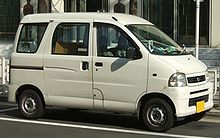
A van is a type of road vehicle used for transporting goods or people. Depending on the type of van, it can be bigger or smaller than a pickup truck and SUV, and bigger than a common car. There is some variation in the scope of the word across the different English-speaking countries. The smallest vans, microvans, are used for transporting either goods or people in tiny quantities. Mini MPVs, compact MPVs, and MPVs are all small vans usually used for transporting people in small quantities. Larger vans with passenger seats are used for institutional purposes, such as transporting students. Larger vans with only front seats are often used for business purposes, to carry goods and equipment. Specially equipped vans are used by television stations as mobile studios. Postal services and courier companies use large step vans to deliver packages.
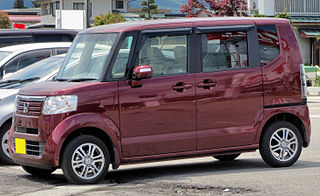
Kei car, is the Japanese vehicle category for the smallest highway-legal passenger cars, with restricted dimensions and engine capacity. Similar Japanese categories exist for microvans, and kei trucks. These vehicles are most often the Japanese equivalent of the EU A-segment.
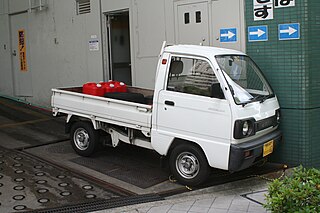
The Autozam Scrum, later known as Mazda Scrum, is a cabover microvan and kei truck sold exclusively in Japan by Japanese automaker Mazda. Originally part of the company's Autozam marque, it was first introduced in June 1989. Mazda still sells the Scrum under its own name. The Scrum is a rebadged version of the Suzuki Carry/Every and used Suzuki engines. The first model year had 550-cc (cm3) Suzuki F5B engines producing 34 PS or 25 kW, or 52 PS or 38 kW with an intercooled turbo; after only nine months, this was replaced by the larger-engined DG/DH51 as the kei car standards were changed that year.
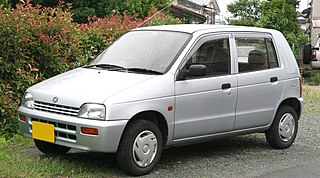
The Suzuki Alto is a kei car produced by Suzuki since 1979. The model, currently in its ninth generation, was first introduced in 1979 and has been built in many countries worldwide. The Alto originated as a commercial vehicle derivative of the Fronte, but over time the Alto nameplate gained in popularity and by 1988 it replaced the Fronte name completely. The Alto badge has often been used on different cars in Japan and in export markets, where it is considered a city car.

The Mitsubishi Minica is a kei car produced by Mitsubishi Motors mainly for the Japanese domestic market from 1962 to 2011. It was first built by Shin Mitsubishi Heavy-Industries, one of Mitsubishi Heavy Industries' three regional automotive companies until they were merged in 1964, and as such predates MMC itself. In Japan, it was sold at a specific retail chain called Galant Shop. In 2007 and 2011, the car was replaced with the Mitsubishi eK and the Mitsubishi i.

Hafei, officially Hafei Motor Co., Ltd., is a Chinese automaker currently operating as a subsidiary of Changan Ford, and manufacturing passenger vehicles.

The Daihatsu Hijet is a cab over microvan and kei truck produced and sold by the Japanese automaker Daihatsu since 1960. Despite the similarities between the Hijet name and Toyota's naming scheme for its trucks and vans, the name "Hijet" has been in use for Daihatsu's kei trucks and microvans since 1960, over two decades before Toyota took control. "Hijet", when transliterated into Japanese, is very similar to "Midget", one of Daihatsu's other mini-trucks. According to Daihatsu, the name "Hijet" was created to imply that the vehicle offers higher performance than the Midget. The Hijet competes in Japan with the Honda Acty, Mitsubishi Minicab, Nissan Clipper, Subaru Sambar and Suzuki Carry.

The Honda Acty is a series of cabover microvans and kei trucks produced by the Japanese automaker Honda from 1977 to 2021, designed for the Japanese domestic market (JDM). "Acty" is short for "Activity".

The Subaru Sambar is a cabover truck and microvan manufactured and marketed by Subaru as Japan's first truck compliant with the country's strict Keitora (軽トラ) or Kei vehicle tax class. Introduced in 1961 in microvan and Kei pickup configurations, the Sambar remains in production, now in its eighth generation — beginning with the sixth generation as a rebadged Daihatsu Hijet.

The Mitsubishi Delica is a range of vans and pickup trucks designed and built by the Japanese automaker Mitsubishi Motors since 1968. It was originally based on a cabover van and pickup truck introduced the previous year, also called the Delica, its name a contraction of the English language phrase Delivery car. This pickup truck, and a commercial van derived from it has received many names in export markets, being sold as the L300 in Europe, Jamaica and New Zealand, Express and Starwagon in Australia, and plain Mitsubishi Van and Wagon in the United States. The passenger car versions were known as Delica Star Wagon from 1979 until the 1994 introduction of the Delica Space Gear, which became simply Space Gear in Europe at least. The most recent version is called the Delica D:5. With the exception of the first, versions of all generations are still being sold in various international markets.

The Mitsubishi Minicab is a kei truck and microvan, built and sold in Japan by Japanese automaker Mitsubishi Motors since 1966. In Japan, it was sold at a specific retail chain called Galant Shop. It was also sold by China Motor Corporation (CMC) in Taiwan as the CMC Veryca, starting in 1985. A battery electric model of the Minicab, called the Minicab MiEV, is sold in the Japanese market since December 2011.

The Suzuki Carry is a kei truck produced by the Japanese automaker Suzuki. The microvan version was originally called the Carry van until 1982 when the passenger van versions were renamed as the Suzuki Every. In Japan, the Carry and Every are kei cars but the Suzuki Every Plus, the bigger version of Every, had a longer bonnet for safety purposes and a larger 1.3-liter 86-hp (63 kW) four-cylinder engine. They have been sold under myriad different names in several countries, including those with Chevrolet and Ford badges.
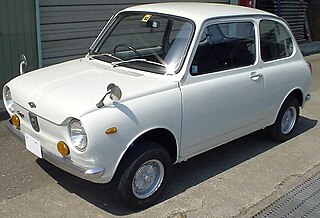
The Subaru R-2 is a kei car manufactured by Subaru from 1969 to 1972. The R-2 was a full model change of the popular Subaru 360, but with an updated appearance and increased interior space. The R-2 appeared approximately one year before the Honda Life, Daihatsu Fellow Max and Suzuki Fronte kei cars, however, it continued to use the powertrain setup from the Subaru 360, which was the EK33 air-cooled 2-cylinder engine installed in the back, which is the inspiration for the name of the vehicle. It appeared around the same time as the second generation Mitsubishi Minica.

The Subaru Sumo, known as Domingo in the Japanese market and as the Libero in European markets except the UK, Iceland, and Sweden, is a cabover microvan produced from 1983 to 1998. In Belgium, it was known as the Combi, in Sweden, it was known as the Columbuss, and in Taiwan the latter generation was marketed as the Estratto. It was also called the Subaru E10 and Subaru E12 respectively in some places, the names referring to the size of the engines.
The Nissan Clipper is an automobile nameplate by Nissan that has been used for two separate commercial vehicle ranges of kei trucks in Japan. Originally, this was just a rebadged version of Prince's "Clipper" light/medium duty commercial vehicle range.

The Hafei Ruiyi is a microvan-derived cabover pickup truck produced by Chinese manufacturer Hafei Motor and developed in partnership with Pininfarina. The Ruiyi is sold in Brazil and Uruguay under the brand Effa Motors.

A kei truck, kei-class truck, or Japanese mini truck is a mini truck, a tiny but practical pickup truck available in rear-wheel drive or four-wheel drive versions, built to satisfy the Japanese keijidōsha statutory class. They are known as keitora in Japan alongside the microvan.

The Wuling Dragon was a series of cabover microvans and kei trucks made by SAIC-GM-Wuling Automobile, the Chinese joint venture with General Motors of the United States of America. The Dragon is the successor of the earlier Liuzhou Wuling LZ110, which was based on the 1977-1984 Mitsubishi Minicab.
Dongfeng Sokon Automobile known internationally as DFSK Motor, was a joint venture between Dongfeng and Chongqing Sokon Industry Group Co Ltd., formed on June 27th, 2003. It is now fully owned by Sokon.

The CMC Veryca (中華菱利) or CMC Varica (中華百利/中華威利) is a cabover kei truck and microvan built and sold in Taiwan by the Taiwanese automaker China Motor Corporation (CMC) (中華汽車) since 1985, with its predecessor entering production in 1978.
